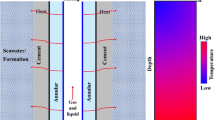Abstract
Wellbore temperature field equations are established with considerations of the enthalpy changes of the natural gas during the deep-water gas well testing. A prediction method for the natural gas hydrate formation region during the deep-water gas well testing is proposed, which combines the wellbore temperature field equations, the phase equilibrium conditions of the natural gas hydrate formation and the calculation methods for the pressure field. Through the sensitivity analysis of the parameters that affect the hydrate formation region, it can be concluded that during the deep-water gas well testing, with the reduction of the gas production rate and the decrease of the geothermal gradient, along with the increase of the depth of water, the hydrate formation region in the wellbore enlarges, the hydrate formation regions differ with different component contents of natural gases, as compared with the pure methane gas, with the increase of ethane and propane, the hydrate formation region expands, the admixture of inhibitors, the type and the concentrations of which can be optimized through the method proposed in the paper, will reduce the hydrate formation region, the throttling effect will lead to the abrupt changes of temperature and pressure, which results in a variation of the hydrate formation region, if the throttling occurs in the shallow part of the wellbore, the temperature will drop too much, which enlarges the hydrate formation region, otherwise, if the throttling occurs in the deep part of the wellbore, the hydrate formation region will be reduced due to the decrease of the pressure.
Similar content being viewed by others
References
REYNA E. M., STEWART S. R. Case history of the removal of a hydrate plug formed during deep water well testing[C]. SPE 67746. Amsterdam, The Netherlands, 2001.
ARRIETA V. V., TORRALBA A. O. and HERNANDEZ P. C. Case history: Lessons learned from retrieval of coiled tubing stuck by massive hydrate plug when well testing in an ultra deep water gas well in Mexico[C]. SPE 140228. Amsterdam, The Netherlands, 2011.
De VITOR ASSIS J., MOHALLEM R. and TRUMMER S. Hydrate remediation during well testing operations in the deepwater campos basin, brazil[C]. SPE 163881. Houston, Texas, USA, 2013.
MAJUMADAR A., MAHMOODAGHDAM E. and BOSHINOI P. R. Equilibrium hydrate formation conditions for hydrogen, sulfide, carbondioxide, and ethane in aqueous solutions of ethylene glycol and sodium chloride[J]. Journal of Chemical Engineering, 2000, 45(1): 20–22.
JAVANMARDI J., MOSHFEGHIAN M. A new approach for prediction of gas hydrate formation conditions inaqueous electrolyte solutions[J]. Fluid Phase Equilibria, 2000, 168(2): 135–148.
JAVANMARDI J., MOSHFEGHIAN M. and MADDOX R. N. An accurate model for prediction of gas hydrate formation conditions in mixtures of aqueous electrolyte solutions and alcohol[J]. The Canadian Journal of Chemical Engineering, 2009, 79(3): 367–373.
DALMAZZONE D., HERZHAFT B. Drifferential scanning calorimetry: A new technique to characterize hydrate formation in drilling muds[C]. SPE78597. Dallas, Texas, USA, 2000.
NASRIFAR K. A model for prediction of gas hydrate formation conditions in aqueous solutions containing electrolytes and/or alcohol[J]. The Journal of Chemical Thermodynamics, 2001, 33(9): 999–1014.
YANG Ding-hui, XU Wen-yue. Effects of salinity on methane gas hydrate system[J]. Science in China Series D: Earth Sciences, 2007, 50(11): 1733–1745.
WANG Zhi-yuan, SUN Bao-jiang. Annular multiphase flow behavior during deep water drilling and the effect of hydrate phase transition[J]. Petroleum Science, 2009, (6): 57–63.
WANG Zhi-yuan, SUN Bao-jiang and CHENG Haiqing. Prediction of gashydrateformationregioninthe wellbore of deepwater drilling[J]. Petroleum Exploration and Development, 2008, 35(6): 731–735.
HASAN A. R., KABIR C. S. Analytic wellbore temperature model for transient gas-well testing[C]. SPE 84288. Denver, Colorado, USA, 2003.
HASAN A. R., KABIR C. S. and LIN D. Analytic wellbore temperature model for transient gas-well testing[J]. SPE Reservoir Evaluation and Engineering, 2005, 8(3): 240–247.
IZGEC B., KABIR C. S. and ZHU D. et al. Transient fluid and heat flow modeling in coupled wellbore/reservoir systems[J]. SPE Reservoir Evaluation and Engineering, 2007, 10(3): 294–301.
YASUNAMI T., SASAKI K. and SUGAI Y. CO2 temperature prediction ininjection tubing considering supercritical condition at Yubari ECBM pilot-test[J]. Journal of Canadian Petroleum Technology, 2010, 49(4): 44–50.
Author information
Authors and Affiliations
Corresponding author
Additional information
Project supported by the National Natural Science Foundation of China (Grant Nos. 51104172, U1262202), the Program for Changjiang Scholars and Innovative Research Team in University (Grant No. IRT1086).
Biography: WANG Zhi-yuan (1981-), Male, Ph. D., Associate Professor
Rights and permissions
About this article
Cite this article
Wang, Zy., Sun, Bj., Wang, Xr. et al. Prediction of natural gas hydrate formation region in wellbore during deep-water gas well testing. J Hydrodyn 26, 568–576 (2014). https://doi.org/10.1016/S1001-6058(14)60064-0
Received:
Revised:
Published:
Issue Date:
DOI: https://doi.org/10.1016/S1001-6058(14)60064-0




